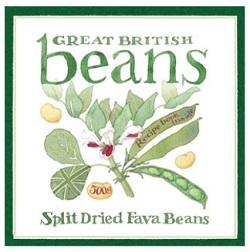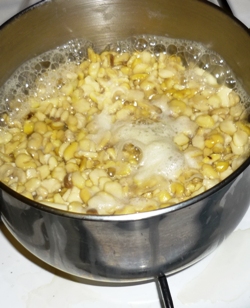Moroccan Bessara with Hodmedod Fava Beans
When a box of Fava beans recently landed on my desk I had to wonder just how we were going to work these into a recipe, since we were not familiar with the little green bean.
But help was on hand, as inside the packet we found a delightful little book of recipes to help us on our way.
So to celebrate National Bean Day (6th January) we donned our aprons and got cooking...
According to the information on the box, Fava beans are delicious, nutritious and good for the soil. Long before fresh broad beans were eaten, the beans were left to ripen and dry on the plant before harvest.
These beans were an important part of the British diet as a source of protein until we started eating more meat and dairy products a few hundred years ago.
Split dried fava beans are very easy to cook and don't need soaking. The beans become softer and softer as they're cooked. So we took on the challenge to try these beans and got to work on creating our Moroccan Bessara. Using 400g from our pack of Fava beans, we set them to cook on a low heat with three large cloves of garlic.
The Moroccan Bessara recipe suggested we cover the beans and garlic and simmer for them 40 minutes, skimming occasionally.
We had to adapt this for our cooker and remove the cover to stop them boiling over - even on a low heat - and make sure we stirred them often to prevent them from burning to the bottom of the pan.
Initially, we used less water than recommended (the recipe suggested this for a dip) but we realised it would be best to start with the amount listed and boil it away for longer at the end if a thicker consistency was required.
It really is a case of common sense and adapting the amount and method to your own cooker and preferences.
Once the beans had softened, after about 40 minutes, we puréed the mixture in a blender, before whisking in the rest of the ingredients.
Prior to adding the paprika we were a tad sceptical about the colour of the dip but advise you to withhold judgement until you have finished cooking.
We eventually created a perfect dip for crudités or fresh bread, that is similar to humus in taste and texture.
Since we ended up with a lot of mixture we will be adding some more liquid to some of the remainder and creating a great tasting soup for our Monday lunch or supper.
Fava beans are fantastic for experimenting with and this recipe can be adapted to incorporate other spices to you own preference and taste.
The beans have a high protein and fibre content and are very filling. This makes them a great alternative for anyone watching their waistline, or looking for something new to add to their store cupboard.
Hodmedod sources produce from British farms to supply the best ingredients.
They are particularly interested in searching out less well-known foods, like the fava bean, which we still grow and export but haven't eaten in Britain for centuries.
Hodmedod Ltd is a new business, founded by Nick Saltmarsh, Josiah Meldrum and William Hudson in 2012 and based on the Norfolk-Suffolk border.
They believe in good, sustainable and local food.
For more information visit www.hodmedods.co.uk Find on Facebook Follow on Twitter
We are definitely looking forward to seeing what else they come up with in 2013.